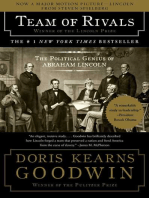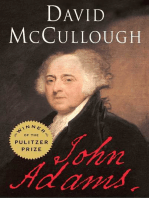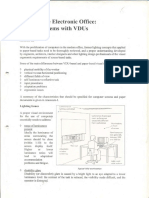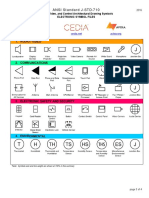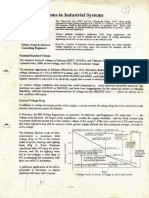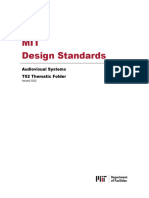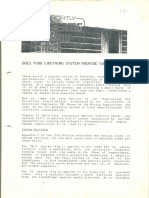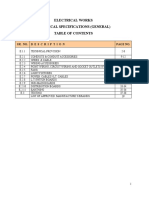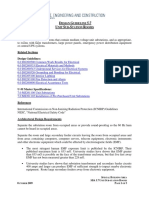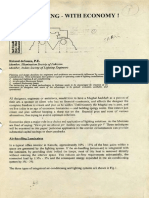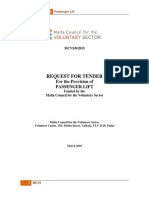Electricity Supply & Tariff
Electricity Supply & Tariff
Uploaded by
naveedfnd0 ratings0% found this document useful (0 votes)
35 views6 pagestechnical paper
Original Title
Electricity supply & tariff
Copyright
© © All Rights Reserved
Available Formats
PDF or read online from Scribd
Share this document
Did you find this document useful?
Is this content inappropriate?
Report this Documenttechnical paper
Copyright:
© All Rights Reserved
Available Formats
Download as PDF or read online from Scribd
Download as pdf
0 ratings0% found this document useful (0 votes)
35 views6 pagesElectricity Supply & Tariff
Electricity Supply & Tariff
Uploaded by
naveedfndtechnical paper
Copyright:
© All Rights Reserved
Available Formats
Download as PDF or read online from Scribd
Download as pdf
You are on page 1of 6
Electricity Supply & Tariffs
in Pakistan: Some Issues
Roland deSouza
FIEEEP
Electrical engineers in Pakistan need to teckle a number of problems in the public interest, including
+ quality of electricity supply in the country
+ confusion in tariffs and their application
+ corruption in utility componies
+ dismal performance of the Electrical Inspector
This can be done quite effectively through the IEEEP, if we have the courage!
The electricity scenario in Pakistan leaves much to be desired:
+ Supply quality and availability is unreliable, with consequent problems for
domestic, industrial, and commercial consumers
+ Safety standards are almost non-existent and not implemented
~ Technical expertise and workmanship is poor
+ Electrical installations and manufactured equipment, built to reduce initial
costs, are of unacceptable standards
~ Corruption in electricity related agencies, like the WAPDA, KESC, and
Electrical Inspector's office has reached epidemic proportions.
As a good professional body of electrical engineers in Pakistan, we have a duty
to our fellow citizens to tackle the problems and evils in our field, and make the
country a safer and better place to live.
Given below are some of the author's ideas on random issues experienced over
the past 25 years
UTILITY TARIFFS
Although an attempt was made in the 80's to unify and rationalise the tariffs of
WAPDA and KESC by providing common rates where possible, many differences
still exist, causing confusion and dissatisfaction among consumers. Some of
them are
+ Maximum Demand Integrating Period in WAPDA areas is 30 minutes, while
in KESC areas it is 15 minutes: the shorter integrating time leads to higher
maximum demand charges in the KESC supply jurisdiction. At one time, KESC
corried out a study, as a group of consumers had complained to the
government, and projected that there would be a substantial loss in their
gross billing if the integrating time was increased from 15 to 30 minutes. A
decision on this matter is still pending with the government, and must be
resolved.
+ Tariffs for Resale of Electricity: Bulk consumers under Tariff C-1 (400V)
and Tariff C-2 (11kV) are permitted to resell electricity to other consumers
within their distribution area. Industrial Tariffs B-1 (400V), 8-2 (400V), 8-3
(11kV) and Commercial Tariff A-2 (400V) specifically forbid resale.
There are a number of commercial buildings (some constructed by State Life
Insurance Corporation, National Insurance Corporation, Bahria Foundation,
and the like) where offices and floors are given on rent. In the KESC area,
Tariffs C-1 & C-2.are available for such buildings, so that sub-meters can be
installed for resale to tenants.
But in WAPDA areas, no transparent or uniform policy exists and commercial
buildings are varyingly given Tariff “A-2 only, or Tariffs A-2/8-3, or
Tariff B-3 only (see Annexure-1) which they resell to their tenants. Thus
much confusion is created while designing the installations (see alternatives
in Annexure-2) which causes a waste of resources that Pakistan can ill
afford, and creates opportunities for corruption of WAPDA officials. A
clear written policy is needed, including an examination of the lawfulness of
reselling electricity
+ Power Tariffs for Commercial Premises: In WAPDA areas, three-phase
(400V) loads in commercial establishments (lighting being metered under
Tariff A-2) are allowed to be metered under Tariffs B-1, or B-2, or B-3.
This facility, which generally results in a lower overall costs to smaller
commercial establishments, is not available in KESC supply areas.
CORRUPTION IN WAPDA & KESC
As both the utility companies are marketing a scarce commodity, the
opportunities to make illegal money are legion
+ New connections/extension in load: Tt has become virtually impossible to
obtain/extend an electric supply connection without paying bribes to a
number of KESC/WAPDA officials. Owner of projects some times find it
difficult to includé these "kickbacks" in their accounts, and it is now becoming
more common for multinationals and government corporations to make the
securing of electricity supply a BOQ line item (rates range from Rs. 1500-
3000 per kW) in the electrical contractor's tender, thus turning contractors
into virtual “dalals*. It has also become common to appoint Electrical
Consultants who have the right “contacts” in WAPDA/KESC and can “arrange”
for the sanction of load.
+ Tampering with meters: With the rising costs of electricity, more and more
utility company staff is involved with helping and encouraging consumers to
“fix their meters in order to reduce their bills. This ranges from fiddling
with the MDI register, to under-reading the kWh consumption, to providing
multiple meters in one residential premises to take advantage the slab
rates of Tariff A-1, and other such schemes.
Collectively known as “line losses", this theft of electricity has reached
alarming proportions, is threatening the viability of the utility companies, and
is actually being paid for by honest consumers in the form of higher
electricity rates.
~Bhatta fo line/repair staff: Especially during times of rain emergency and
summer peaks, breakdowns of lines, transformers, etc. in many areas are not
attended by staff without payment of “extortion” money from consumers.
~ Quality of installations in KESC and WAPDA systems is deplorable. The
installation and maintenance of overhead lines, underground cables,
switchgear, transformers, etc. is done on a “chaltey-ki-nam-gari” basis. Pride
of performance is absent.
+ Over-staffing: The number of employees is far in excess of those actually
required for efficient operation, maintenance, and planning. As “an idle man is
a devil's workshop", detrimental union activity proliferates.
In keeping with the general moral standards of the country, a multitude of
problems exist, including issues like award of contracts, theft, etc. and are
being tackled by citizen's groups like Concerned Citizens Association and KESC
Shareholder’s Association. Engineers need to get involved.
CORRUPTION IN THE ELECTRIC INSPECTOR'S OFFICE
The theoretical role of the Electric Inspector, as a functionary of the Federal
or Provincial Government, is to monitor implementation of the “Electricity Act,
1910", "Electricity Rules, 1937", and related legislation, and to ensure that
electrical installations are safe for the public.
The actual functioning of the offices only ensures that the concerned officials
make illegitimate money and harass electrical consumers and contractors. The
Electrical Inspectors earn “kickbacks” in the following areas, among others:
+ Approval of Electrical Installations: The going rate of bhattais Rs. 100/KVA
(KW..2) of transformer or generator capacity. These costs are also made line
items on BOQs of électrical installation contracts.
+ Issuance of Electrical Contractor's Licence and Certificates of Competency
to Wiremen and Supervisors, and their annual renewal.
+ Annual Inspection of Factories and other Premises: A stereo-type standard
list of deficiencies is generally issued at each inspection (with a great
emphasis on “earthing"), and the Owner has to "remove the deficiencies”
through a Licensed Contractor: most deficiencies are “removed” through the
payment of a negotiated bribe.
~ Approval/Inspection of Temporary Installations at construction sites
provides a regular source of illegal money at 3-month intervals.
The role of the Karachi Electrical Contractors’ Association in negotiating and
settling rates of illegal gratification is also note-worthy: the majority of so-
called “contractors” are of the “brief-case" variety who hang around Block 51,
Pak Secretariat, and stamp/sign forms for a small fee.
Tf the above were not affecting public safety, the matters would only be a part
of the general atmosphere of corruption that pervades our society. But as the
Electric Inspector is corrupt, incompetent, and totally unconcerned about
safety, it is critical that professional and citizen's bodies get involved and force
the government to take corrective action.
IN CONCLUSION
It is the professional duty of all electrical engineers, and especially the role of
a body like the TEEEP, to protect the interests of the general public and ensure
that standards, practices, and inspections are carried out to the highest levels
in order to provide safety from fire, shock and burns to the electricity
consumer.
We must monitor the performance of electricity-related agencies like the
WAPDA, the KESC, and the Electrical Inspector's office to see that the law is
not violated, transparency is established, and that the quality of life in the
country improves,
Annexure 1 & 2
(Roland deSouza is a Partner of Fahim, Nonji & deSouza, « multi-disciplinary firm of electrical and mechanical bulldng
services consultants)
Annexure-1
28" December, 1985
Chairman,
‘Area Electricy Board, WAPDA,
Behind CDA Gtfces,
Islamabad
Dear Mian A. Hanif Sahib,
Re: LACK OF TRANSPARENGY IN APPLICATION OF WAPDA TARIFES.
“The application of WAPOA Tarls to varius projects seems to be entaly atthe discretion of various officss, with th consequent
problems this process generates,
‘Commerciavotice bulings have, of late, faced cifcuty in obtaining a single-tarif 14KV bul-supply under Tarif C-2. Athough te
‘majoc commercial buidings in the KESC area (Habib Bank Plaza, Dawood Cente, She! House, PNSC Gullding, ee, in Karachi)
‘seem to have no problem in operating under a Tari C-2, the comnecilloffice buirings in Islamabad and other majr cies in the
\WAPDA jurisdiction are varyingly fed with Tarif 8-3, or Tart C-2, or Tarif B-3/A-7
‘Tho buldings with an 11kVsingle-tarf,n our knowedge, ncude
= World Bank Buiicing, islamabad
~ Experts Advisory Call Building, Islamabad
PTC HO Bullding-A, Islamabad
= PTCHG Building, ilamatad
= Enercon Building lamabad
= Saudi Pak Tower, Islamabad Tari 8-3
= KRU Bulding,islamagad
State Life Buicing,ltamabad Tani 8-3
= _ USAID Building, Islamabad Tarif a2
= ABL Bulding, Islamabad Teri 8-3
= Sta Life Building, Lahore Tarif A2
= State Life Building, Peshawar Tait A2
‘The recent insistence of some WAPDA offices thatthe consumer use Tarif B-W/A-2 at 1IkV doos not make sense, as
‘ola loads of under 1000KVA would require two smaller, uneconomicaly-sized vaneformers, which would load the (elteady
‘overloaded) WAPDA sysiem wit reactive power,
addtional expenditure on exta MV & LV svitchgearicabling would be involved
= Space requirements inthe bulding would increase
changeover arrangements fr standby generators becomes complicated
‘waste of scare national esouroes resus!
‘Additonal, since Tarits 8-2 and A2 do not permit reeling of electricity, commercial premises with tenans (Ike State Life
Buldings) Would not be able o sub-meter. Tan C-2 i re-saleable.
We suggest that WAPDA (and KESC) establish a uniform, tranaparent poloy and publcee it widely to consumers, architects and
ectical designers to reduce causion and corupton. We also suggest that Tariff C-2 be made easly availabe, ag thas been
‘he past to all mulistoreyed corimerca office buildings.
In some rare cases, Tats 8-3 and A.2 are desable or metering power and lighting separataly I should bo permissible to sub-
miter (Tai A-2) the ighting loads on the LV side ofa single wansformer, and subtract the energy/MD\ readings fom the Tari 8-3
ower readings onthe incoming MV sie of he same vansformer.
‘Your urgent attention to this problem is sliced, as the matte is pending on 2 number of projec in Islamabad (and other cles).
Yours fatty
(Ratand deSouza)
for FAHIM, NANA & DESOUZA
6c. Chairman WAPDA, Lahore
Federal Minister fo: Power, tsiamabad
‘Note: To date (20-287), no answer had been received to the above lator.
puowep wnuixow ¢-E HUOL Jo vO! goad
sasno> (eiqouajesd) Z—2nn0ws93y
ut jo, Bupoot sf Boer a x
rparekys ‘Touomppe pub rt nes ee mon i
z-9 MMOL ‘ c-a wei [] \ c-¥ sHYOL x M [7]c-8 yen
wl3n 9539 wan oan asin vag 3513" Yoav
vat 0008 yr1 0001 we 00% vr oe
z-¥ OL
so01g 184
en won
zy HPL Zay me
wiign-ens wiign-ens
Jenod a sano
¥algn-ens
sols PY
ee 1
aaah temed Z=9 HCL
aSian-ans f
iE
soos 92¢
e-aAnouseyy Z—eanouserly j-eanqowariy i
SBHuIpjing |DIOWaWILUOD aqojUeYy 40} S44/40
Ey g 10! ) ajqoyuey 4Oj SJL
[el ec
You might also like
- The Subtle Art of Not Giving a F*ck: A Counterintuitive Approach to Living a Good LifeFrom EverandThe Subtle Art of Not Giving a F*ck: A Counterintuitive Approach to Living a Good LifeRating: 4 out of 5 stars4/5 (5867)
- The Gifts of Imperfection: Let Go of Who You Think You're Supposed to Be and Embrace Who You AreFrom EverandThe Gifts of Imperfection: Let Go of Who You Think You're Supposed to Be and Embrace Who You AreRating: 4 out of 5 stars4/5 (1094)
- Never Split the Difference: Negotiating As If Your Life Depended On ItFrom EverandNever Split the Difference: Negotiating As If Your Life Depended On ItRating: 4.5 out of 5 stars4.5/5 (866)
- Grit: The Power of Passion and PerseveranceFrom EverandGrit: The Power of Passion and PerseveranceRating: 4 out of 5 stars4/5 (597)
- Hidden Figures: The American Dream and the Untold Story of the Black Women Mathematicians Who Helped Win the Space RaceFrom EverandHidden Figures: The American Dream and the Untold Story of the Black Women Mathematicians Who Helped Win the Space RaceRating: 4 out of 5 stars4/5 (909)
- Shoe Dog: A Memoir by the Creator of NikeFrom EverandShoe Dog: A Memoir by the Creator of NikeRating: 4.5 out of 5 stars4.5/5 (543)
- The Hard Thing About Hard Things: Building a Business When There Are No Easy AnswersFrom EverandThe Hard Thing About Hard Things: Building a Business When There Are No Easy AnswersRating: 4.5 out of 5 stars4.5/5 (352)
- Elon Musk: Tesla, SpaceX, and the Quest for a Fantastic FutureFrom EverandElon Musk: Tesla, SpaceX, and the Quest for a Fantastic FutureRating: 4.5 out of 5 stars4.5/5 (474)
- Her Body and Other Parties: StoriesFrom EverandHer Body and Other Parties: StoriesRating: 4 out of 5 stars4/5 (824)
- The Emperor of All Maladies: A Biography of CancerFrom EverandThe Emperor of All Maladies: A Biography of CancerRating: 4.5 out of 5 stars4.5/5 (272)
- The Sympathizer: A Novel (Pulitzer Prize for Fiction)From EverandThe Sympathizer: A Novel (Pulitzer Prize for Fiction)Rating: 4.5 out of 5 stars4.5/5 (122)
- The Little Book of Hygge: Danish Secrets to Happy LivingFrom EverandThe Little Book of Hygge: Danish Secrets to Happy LivingRating: 3.5 out of 5 stars3.5/5 (411)
- The Yellow House: A Memoir (2019 National Book Award Winner)From EverandThe Yellow House: A Memoir (2019 National Book Award Winner)Rating: 4 out of 5 stars4/5 (98)
- The World Is Flat 3.0: A Brief History of the Twenty-first CenturyFrom EverandThe World Is Flat 3.0: A Brief History of the Twenty-first CenturyRating: 3.5 out of 5 stars3.5/5 (2268)
- Devil in the Grove: Thurgood Marshall, the Groveland Boys, and the Dawn of a New AmericaFrom EverandDevil in the Grove: Thurgood Marshall, the Groveland Boys, and the Dawn of a New AmericaRating: 4.5 out of 5 stars4.5/5 (268)
- Team of Rivals: The Political Genius of Abraham LincolnFrom EverandTeam of Rivals: The Political Genius of Abraham LincolnRating: 4.5 out of 5 stars4.5/5 (235)
- A Heartbreaking Work Of Staggering Genius: A Memoir Based on a True StoryFrom EverandA Heartbreaking Work Of Staggering Genius: A Memoir Based on a True StoryRating: 3.5 out of 5 stars3.5/5 (232)
- On Fire: The (Burning) Case for a Green New DealFrom EverandOn Fire: The (Burning) Case for a Green New DealRating: 4 out of 5 stars4/5 (74)
- The Unwinding: An Inner History of the New AmericaFrom EverandThe Unwinding: An Inner History of the New AmericaRating: 4 out of 5 stars4/5 (45)
- Lighting The Electronic Glare Problems With VdusDocument13 pagesLighting The Electronic Glare Problems With VdusnaveedfndNo ratings yet
- Summary ANSI J STD 710 Symbols Aug2018Document2 pagesSummary ANSI J STD 710 Symbols Aug2018naveedfndNo ratings yet
- Voltage Problems in Industrial SystemsDocument9 pagesVoltage Problems in Industrial SystemsnaveedfndNo ratings yet
- T02 - Audiovisual Systems 2022Document23 pagesT02 - Audiovisual Systems 2022naveedfndNo ratings yet
- Page 101Document1 pagePage 101naveedfndNo ratings yet
- Elevators in High Rise BuildingsDocument8 pagesElevators in High Rise BuildingsnaveedfndNo ratings yet
- Direct On Line or Star DeltaDocument6 pagesDirect On Line or Star DeltanaveedfndNo ratings yet
- Importance of Electrical & MechDocument2 pagesImportance of Electrical & MechnaveedfndNo ratings yet
- Distribution Generation Aluminium CablesDocument11 pagesDistribution Generation Aluminium CablesnaveedfndNo ratings yet
- A New Control System For High Rise ElevatorsDocument12 pagesA New Control System For High Rise ElevatorsnaveedfndNo ratings yet
- Earth Leakage ProtectionDocument6 pagesEarth Leakage ProtectionnaveedfndNo ratings yet
- Does Your Earthing System Provide SafetyDocument8 pagesDoes Your Earthing System Provide SafetynaveedfndNo ratings yet
- Electrical Works Technical Specifications (General) : Sr. No.D E S C R I P T I O N Page NoDocument17 pagesElectrical Works Technical Specifications (General) : Sr. No.D E S C R I P T I O N Page NonaveedfndNo ratings yet
- SBA5.7Document5 pagesSBA5.7naveedfndNo ratings yet
- Lighting With EconomyDocument6 pagesLighting With EconomynaveedfndNo ratings yet
- Electrical Equipment Floor Space: Application Paper AP083007ENDocument8 pagesElectrical Equipment Floor Space: Application Paper AP083007ENnaveedfndNo ratings yet
- X618 BrochureDocument8 pagesX618 BrochurenaveedfndNo ratings yet
- Request For Tender: For The Provision of Passenger LiftDocument40 pagesRequest For Tender: For The Provision of Passenger LiftnaveedfndNo ratings yet
- WavePro LT. Busway SystemDocument44 pagesWavePro LT. Busway SystemnaveedfndNo ratings yet
- 209 Guide To Security TurnstilesDocument13 pages209 Guide To Security TurnstilesnaveedfndNo ratings yet
- Abloy: Europrofile Handle Controlled LocksDocument6 pagesAbloy: Europrofile Handle Controlled LocksnaveedfndNo ratings yet
- World Class: Electric LocksDocument32 pagesWorld Class: Electric LocksnaveedfndNo ratings yet




























